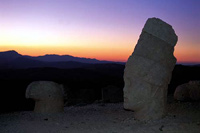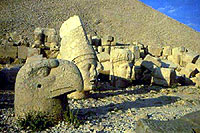Nemrut
 At the junction of the East and West civilisations, Nemrut Dagi (Mount Nemrut) is one of the most astounding sites in Türkiye: A collection of colossal statues on a remote mountain 2150m high, adorning the temple and tomb of King Antiochus. Unknown until 1881 when an Ottoman geologist discovered these 10 metre-high stone heads, archaeological work began in 1953 to uncover their history.
At the junction of the East and West civilisations, Nemrut Dagi (Mount Nemrut) is one of the most astounding sites in Türkiye: A collection of colossal statues on a remote mountain 2150m high, adorning the temple and tomb of King Antiochus. Unknown until 1881 when an Ottoman geologist discovered these 10 metre-high stone heads, archaeological work began in 1953 to uncover their history.
Nemrut Dağı has since been a significant attraction, with thousands sunrise and sunset visitors to see the stones in the best possible light. It has been designated a World Cultural Heritage site by UNESCO, and is one of the most important National Parks in the country. In addition to the statues, the entire site includes art from the Commagene civilisation, the Eskikale (Old Castle), Yenikale (New Castle), Karakus Hill and Cendere Bridge. Most people use the nearby towns of Malatya, Kahta or Adıyaman as a base, and the road to the summit is only open from mid-April to mid-October because of heavy snow the rest of the year.
History
Lying between the Seleucid and the Parthian Empires from 250 BC, this area has had a strategic location, and has benefited from a rich and fertile land, and a succession of independent thinking rulers. Breaking away from the Seleucid Empire, Mithridates I Callinicus founded the independent Commagene Kingdom in 109 BC, and set up his capital in Arsameia. He was the son of a prince, and claims ancestry with Alexander the Great and Darius the Great, King of Persia.
The Commagene Kingdom was a powerful one, priding itself on having religions, culture and traditions of the Greek and Persian cultures blended into one. He died in 64 BC, and was succeeded by his son Antiochus I Epiphanes, who showed his ability early on as a statesman by declaring a non-aggression treaty with the Romans.
 After a financially and politically successful start to his rule, Antiochus deemed himself worthy of god-like status, and ordered the building of a temple and funerary mound in his honour. Its size and location was a reflection of his ego and thoughts of his immortality, and he declared that when he died his spirit would join the god Zeus in heaven.
After a financially and politically successful start to his rule, Antiochus deemed himself worthy of god-like status, and ordered the building of a temple and funerary mound in his honour. Its size and location was a reflection of his ego and thoughts of his immortality, and he declared that when he died his spirit would join the god Zeus in heaven.
But the huge statues of Antiochus and the gods are all that remain of his reign, as his short-lived rule ended in 38 BC after he sided with the Parthians and fell out with the Romans, who later deposed him. The Commagene Kingdom was then taken over by the Romans.
Antiochus and his statues were all but forgotten for centuries until Karl Puchstein, a German engineer, stumbled across them whilst surveying the site in 1881. Two years later he returned with Karl Humann for a closer inspection, but is was not until 1953 that a team of American archaeologists returned and did a thorough survey. Since then, the site has been one of the most popular attractions in Türkiye, despite its remote location
 Climate
Climate
For visitors hiking to the top of Nemrut Dagi, the top of the mountain gets very cold at sunrise and sunset, even in summer. The higher land is snow covered for nearly half the year. Otherwise, the summer daytime temperature of the plains is extremely hot and dry reaching over 30 degrees, with winters cold and wet and plummeting well below freezing point.